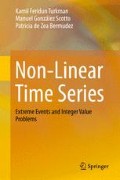Abstract
We have seen in Sect. 2.1.4 that nonlinear processes, due to their dependence on initial conditions, often magnify error causing unstable behavior. Even when stationary solutions exist, this noise magnification and dependence on initial conditions reflects on the tails of the stationary distribution, as well as on how large values cluster.
Access this chapter
Tax calculation will be finalised at checkout
Purchases are for personal use only
Notes
- 1.
Extensions of Goldie and Grbel’s results, namely the connection between the tails of R and the behavior of A near 1, can be found in Hitczenko and Wesolowski (2009).
References
Andrews B, Calder M, Davis RA (2009) Maximum likelihood estimation for α-stable autoregressive processes. Ann Stat 37:1946–1982
Basrak B, Davis RA, Mikosch T (2002) Regular variation of GARCH processes. Stoch Process Appl 99:95–115
Beirlant J, Goegebeur Y, Segers J, Teugels J (2004) Statistics of extremes: theory and applications. Wiley, Chichester
Bougerol P, Picard N (1992) Strict stationarity of generalized autoregressive processes. Ann Probab 20:1714–1730
Brandt A (1986) The stochastic equation \(Y _{n+1} = A_{n}Y _{n} + B_{n}\) with stationary coefficients. Adv Appl Probab 18:211–220
Brockwell PJ, Davis RA (1991) Time series: theory and methods. Springer, New York
Calder M, Davis RA (1998) Inference for linear processes with stable noise. In: Adler RJ, Feldman RE, Taqqu MS (eds) A practical guide to heavy tails. Birkhäuser, Boston, pp 159–176
Cline D (1983) Estimation and linear prediction for regression, autoregression and ARMA with infinite varaiance data. Ph.D. Theses, Dept. of Statistics, Colorado State University, Fort Collins
Davis RA (1996) Gauss-Newton and M-estimation for ARMA processes with infinite variance. Stoch Process Appl 63:75–95
Davis RA, Resnick SI (1985) Limit theory for moving averages of random variables with regularly varying tail probability. Ann Probab 13:179–195
Davis RA, Resnick SI (1996) Limit theory for bilinear processes with heavy tailed noise. Ann Appl Probab 6:1191–1210
Draisma G, Drees H, Ferreira A, de Haan L (2004) Bivariate tail estimation; dependence in asymptotic independence. Bernoulli 10:251–280; 25:721–736
Drees H, Rootzen H (2010) Limit theorems for empirical processes of cluster functionals. Ann Stat 38:2145–2186
Embrechts P, Goldie C (1994) Perpetuities and random equations. In: Mandl P, Huskova M (eds) Asymptotic statistics: proceedings of fifth Prague symposium. Physica, Heidelbeg, pp 75–86
Embrechts P, Klüppelberg C, Mikosch T (1997) Modelling extremal events for insurance and finance. Springer, Heildelberg
Goldie CM (1991) Implicit renewal theory and tails of solutions of random equations. Ann Appl Probab 1:126–166
Goldie CM, Grübel R (1996) Perpetuities with thin tails. Adv Appl Probab 28:463–480
Grey DR (1994) Regular variation in the tail behaviour of solutions of random difference equations. Ann Appl Probab 4:169–183
Grincevicčius AK (1975) One limit distribution for a random walk on the line. Lithuanian Math J 15:580–589. (English translation)
Hill BM (1975) A simple general approach to inference about the tail of a distribution. Ann Stat 3:1163–1174
Hitczenko P, Wesolowski J (2009) Perpetuities with thin tails revisited. Ann. Appl. Probab. 19:2080–2101
Kesten H (1973) Random difference equations and renewal theory for products of random matrices. Acta Math 131:207–248
Klüppelberg C, Lindner A (2005) Extreme value theory for moving average processes with light-tailed innovations. Bernoulli 11:381–410
Leadbetter MR, Lindgren G, Rootzén H (1983) Extremes and related properties of random sequences and processes. Springer, New York
Ledford AW, Tawn JA (1996) Statistics for near dependence in multivariate extreme values. Biometrika 83:169–187
Mathews VJ, Sicuranza GL (2000) Polynomial signal processing. Wiley, New York
Pham DT (1985) Bilinear Markovian representation and bilinear model. Stoch Proc Appl 20:295–306
Resnick SI (1987) Extreme values, regular variation and point processes. Springer, New York
Resnick SI (1998) Why non-linearities can ruin the heavy-tailed modeler’s day. In: Adler RJ, Feldman RE, Taqqu MS (eds) A practical guide to heavy tails. Birkhäuser, Boston, pp 219–239
Resnick SI (2007) Heavy-tail phenomena: probabilistic and statistical modeling. Springer, New York
Resnick SI, Van den Berg E (2000) Sample correlation behaviour for the heavy tailed general bilinear process. Stoch Models 16:233–258
Rootzén H (1986) Extreme value theory for moving average processes. Ann Probab 14:612–652
Scotto MG, Turkman KF (2005) Extremes of Volterra series expansions with heavy-tailed innovations. Nonlinear Anal Theory Methods Appl 63:106–122
Subba Rao T, Gabr MM (1984) An introduction to bispectral analysis and bilinear time series models. Springer, New York
Turkman KF, Amaral Turkman MA (1997) Extremes of bilinear time series models. J Time Ser Anal 18:305–320
Vervaat W (1979) On a stochastic difference equation and a representation of non-negative infinitely divisible random variables. Adv Appl Probab 11:750–783
Author information
Authors and Affiliations
Rights and permissions
Copyright information
© 2014 Springer International Publishing Switzerland
About this chapter
Cite this chapter
Turkman, K.F., Scotto, M.G., de Zea Bermudez, P. (2014). Extremes of Nonlinear Time Series. In: Non-Linear Time Series. Springer, Cham. https://doi.org/10.1007/978-3-319-07028-5_3
Download citation
DOI: https://doi.org/10.1007/978-3-319-07028-5_3
Published:
Publisher Name: Springer, Cham
Print ISBN: 978-3-319-07027-8
Online ISBN: 978-3-319-07028-5
eBook Packages: Mathematics and StatisticsMathematics and Statistics (R0)

